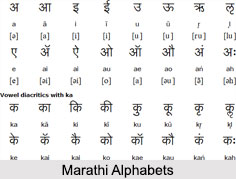 Marathi is an Indo Aryan language spoken by the Marathi people of western India (Maharshtrians). It serves as the official language of Maharashtra. Marathi language was earlier known as Maharashtri, Maharathi, Malhatee or Marthi in ancient times. Marathi is supposed to be more than 1300 years old, having evolved from Sanskrit, which eventually was derived from Prakrit and Apabhramsha. Its grammar and syntax are said to have originated from Pali and Prakrit.
Marathi is an Indo Aryan language spoken by the Marathi people of western India (Maharshtrians). It serves as the official language of Maharashtra. Marathi language was earlier known as Maharashtri, Maharathi, Malhatee or Marthi in ancient times. Marathi is supposed to be more than 1300 years old, having evolved from Sanskrit, which eventually was derived from Prakrit and Apabhramsha. Its grammar and syntax are said to have originated from Pali and Prakrit.
Literary Works in Marathi Language
Marathi has a long literary tradition where the literary works of the saint and poet Dnyaneshwar, are very popular. Other famous saint-poets include Eknath, Tukaram and Namdev, who were instrumental in enriching the Marathi language. Thus, Marathi is said to have the richest saint-literature of all Indian languages. The first Marathi text was written in the 11th century as inscriptions on stones and copper plates. From the 13th to the mid 20th century, it was written in the Modi alphabet and since 1950, it is being written in the Devanagiri alphabet.
Use of Marathi Language
After 1187 CE, the use of Marathi grew substantially in the inscriptions of the Seuna (Yadava) kings, who earlier used Kannada and Sanskrit language in their inscriptions. Marathi was widely used during the Sultanate period as well. Although the rulers were Muslims, the local landlords and the revenue collectors were Hindus and so was the majority of the population. Hence, to simplify the administration and revenue collection, the sultans promoted the use of Marathi in official documents. Marathi also became the language of administration during the Ahmadnagar Sultanate and Adilshahi Sultanate of Bijapur.
Persian Influence in Marathi Language
Marathi language has a huge influence of Persian language. Several Persian words have been derived in Marathi language like bag (Garden), karkhana (factory), shahar (city), bazar (market), dukan (shop), hushar (clever), kagaj (paper), khursi (chair), jamin (land), jahirat (advertisement), and hazar (thousand) etc.
Marathi Language during Maratha Empire
Marathi gained prominence with the rise of the Maratha Empire beginning with the reign of Chhatrapati Shivaji Maharaj. Under Shivaji, the language became less Persianised also. This period also saw the use of Marathi language in transactions of land and other business as well. Thus, documents from this period give a better picture of the life of common people. There are a lot of Bakharis written in Marathi and Modi script from this period.
Marathi Language during British Rule
The British colonial period starting in early 1800s saw standardisation of Marathi grammar through the efforts of the Christian missionary William Carey. Translations of the Bible were first books to be printed in Marathi. These translations by William Carey, the American Marathi mission and the Scottish missionaries led to the development of Marathi, which is called the "Missionary Marathi" in early 1800s.



















